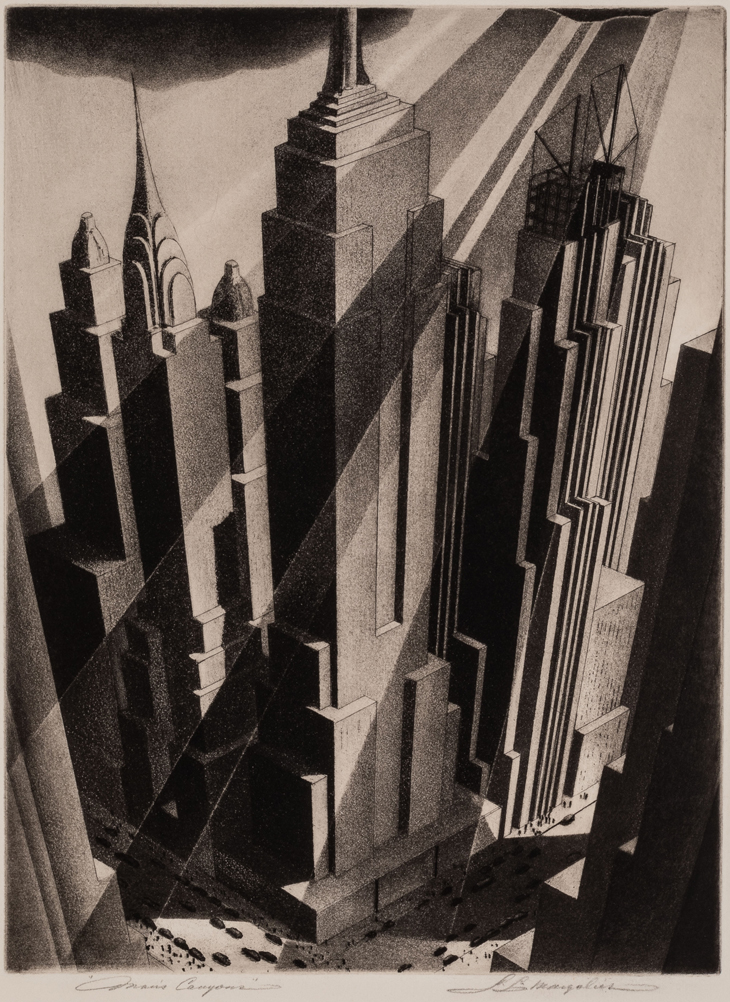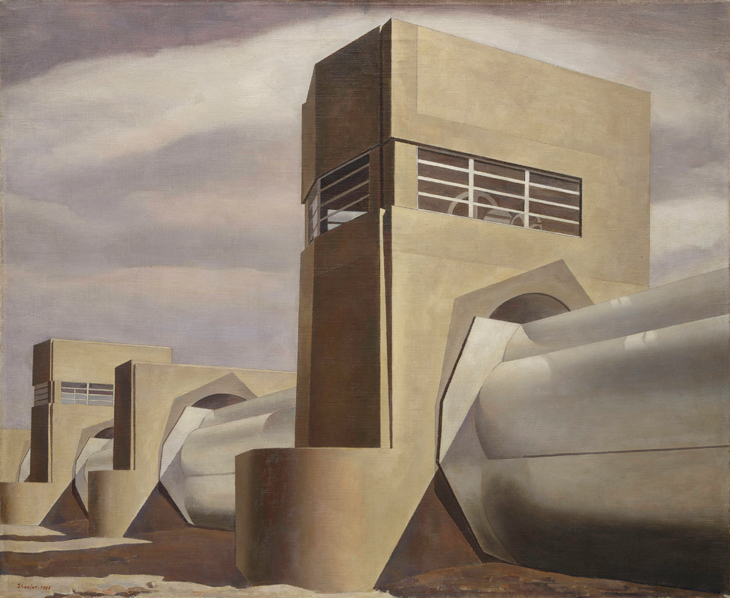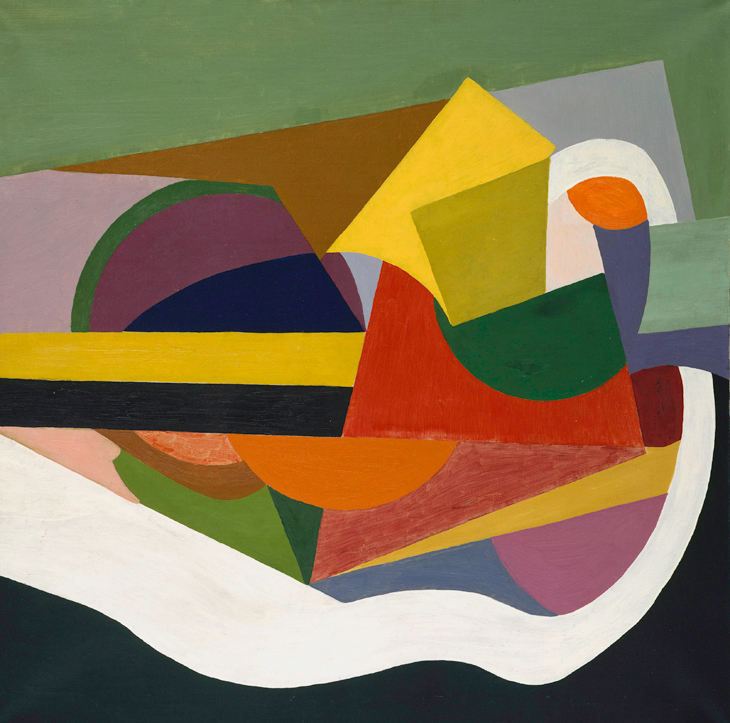To call a person or a thing ‘cool’ is usually to say that they are hip, on trend, socially successful or fashionably attractive. ‘America’s Cool Modernism’ at the Ashmolean, which focuses on art produced between 1915 and ’45, offers a different definition. Absent here are the striking sartorial styles of the flappers of the Roaring Twenties, or Allen Ginsberg’s ‘angelheaded hipsters’ of a fledgling Beat movement. ‘Cool’ here means restrained, detached, composed. And with very few people.
Of the 93 predominantly representational works exhibited, only 11 depict the human figure. These few people are routinely obscured by the gargantuan structures of American industrialism or dwarfed by collosal, empty urban spaces. Berenice Abbott’s photographs show Manhattan’s new monuments to corporate finance from below, converging to a vanishing point and inducing in the viewer a vertiginous nausea. In Samuel Margioles’s etching and aquatint Man’s Canyon (1936), we overlook windowless skyscrapers from an other-worldly vantage point, cars like insects scuttling on the ground below. These images have an immediate familiarity, imprinted as they are on to the popular imagination of an early 20th-century America building bigger and building taller.

Man’s Canyon (1936), Samuel Margolies. Terra Foundation for American Art. © Estate of the artist
The two artists named in the exhibition’s title, Georgia O’Keeffe and Edward Hopper, have become incredibly famous. They will be the reason for many people visiting the Ashmolean this spring. O’Keeffe had a major retrospective at the Tate two years ago, and Hopper is widely recognised as the great chronicler of urban loneliness. And yet in the exhibition catalogue Ashmolean director Xa Sturgis notes that, remarkably, ‘there are no American paintings by any of the artists […] in any UK public collection and very few in Europe’. The case apparently being made here is that, between Whistler and Sargent (who are more or less taken as Europeans anyway) and the gestural abstraction of the mid-century, there is a blind spot in our understanding of American modern art. There is some truth to this, and we can enjoy a rare chance to see so many works (again, remarkably) never before loaned from the United States. With that said, for such a vast topic the exhibition is somewhat modestly scaled – and we might wonder why Arthur Dove’s dreadful seascapes fit the bill of cool modernism but the far more exciting, and pertinent, Morton Schamberg gets just one painting, his Untitled (Mechanical Abstraction) of 1916.

Water (1945), Charles Sheeler. Metropolitan Museum of Art, New York. © Estate of Charles Sheeler
In many of the best works, caught between wonder and terror, there is the sense of some apprehension of the sublime – as though art were belatedly understood to be ill-equipped to render the size and scale of the subject. Just as the invention of the elevator was a precondition for the invention of the skyscraper, so too it seems that the invention of the skyscraper was a precondition for the kinds of angular modernism on display here. This thesis is presented most convincingly in the work of Charles Sheeler, an artist interested in the precision architecture of residential, industrial and agricultural constructions. Take MacDougal Alley (1924), where shadows cast by the vivid red-brick buildings are sheer blocks of black, and back windows are rectangles opening on to apartments that appear uninhabited; take Water (1945), in which a generic hydraulic plant stands in an arid, depopulated environment, an image devoid of the natural resource evoked in its title.
But there is more here than the cool and cold of modern production facilities. The poet William Carlos Williams, a friend of Sheeler’s, noted that ‘inhuman is a word commonly used to describe the efficiency of the modern industrial setup, as in some minds coldness is often associated with Sheeler’s work – incorrectly.’ Perhaps Williams was thinking of Manhatta, Sheeler’s collaboration with Paul Strand. In this early film from 1921, flickering images of a rapidly expanding New York, where girders vault frenetically into the sky, are interspersed with romantic lines from Walt Whitman’s poetry. ‘Where our tall topt / marble and iron beauties / range on opposite sides’, reads one slide, an evocation of the humanist poet clearly seeking to connect the shared experience of the city with an American tradition that finds aesthetic wonder in the new.

Sound (1919), ee cummings. Metropolitan Museum of Art, New York. © The Estate of ee cummings
Poets play a big part throughout the exhibition, gesturing to the explosion of the American idiom across art forms, as in the synaesthetic patterns of ee cummings’s Sound (1919). In the lines, oblongs and curvilinear shapes of a guitar painted in bright and joyous colour, we are reminded that American modernism between the wars had much more to say, more contexts in which to connect and refer, than the detached observations on impersonal landscapes that are the focus here. But the real knockout work, and certainly the most widely recognised in the US if not in Britain, is Charles Demuth’s I See the Figure 5 in Gold (1928), an ekphrasis-in-reverse homage to the William Carlos Williams poem ‘The Great Figure’. The painting is full of energy and movement, as the titular figure multiplies and expands, exuding from the broken Cubist planes of a red fire truck careering through the nocturnal streets. On the margins of the painting, the little textual nods to Williams – ‘W. C. W.’, ‘CARLO[S]’, ‘BILL’ – are reminiscent of the latest developments in advertising billboards in their typeface and proliferation across the street scene.

I Saw the Figure 5 in Gold (1928), Charles Demuth. © Metropolitan Museum of Art, New York
‘America’s Cool Modernism’ is a show that reacquaints us with the beginnings of American modernism, and in this regard it is a solid success. It might have been more successful if it challenged some of our preconceptions of an interwar American art obsessed by materialism, the machine and enormous architecture, or if it applied some pressure on the conviction that many of these works were ‘cool’ in the detached sense at all. But with that said, it is a wonderful opportunity to see so many artworks from the period in this country for the first time – and hopefully not for the last.
‘America’s Cool Modernism: O’Keeffe to Hopper’ is at the Ashmolean, Oxford, until 22 July.














![Masterpiece [Re]discovery 2022. Photo: Ben Fisher Photography, courtesy of Masterpiece London](http://zephr.apollo-magazine.com/wp-content/uploads/2022/07/MPL2022_4263.jpg)
‘Like landscape, his objects seem to breathe’: Gordon Baldwin (1932–2025)